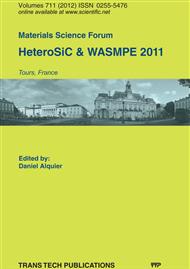p.104
p.109
p.114
p.118
p.124
p.129
p.134
p.141
p.149
High Temperature Capability of High Voltage 4H-SiC JBS
Abstract:
This paper presents the high blocking capability of the 4H-SiC tungsten Schottky and junction barrier Schottky (JBS) diodes at room temperature as well as at high operating temperature. First, we present the design of the proposed devices and the process employed for their fabrication. In a second part, their forward and reverse characteristics at room temperature will be presented. Our rectifiers exhibit blocking capability up to 9kV at room temperature. Then, we investigate the reverse current behaviour at 5kV from room temperature to 250°C under vacuum. JBS and Schottky devices that are capable to block 8kV at room temperature, show leakage current inferior to 100µA at 250°C when reverse biased at 5kV. It confirms the capability of Silicon Carbide to produce devices capable of operation at temperatures and voltages above the Silicon limits.
Info:
Periodical:
Pages:
124-128
Citation:
Online since:
January 2012
Price:
Сopyright:
© 2012 Trans Tech Publications Ltd. All Rights Reserved
Share:
Citation:


